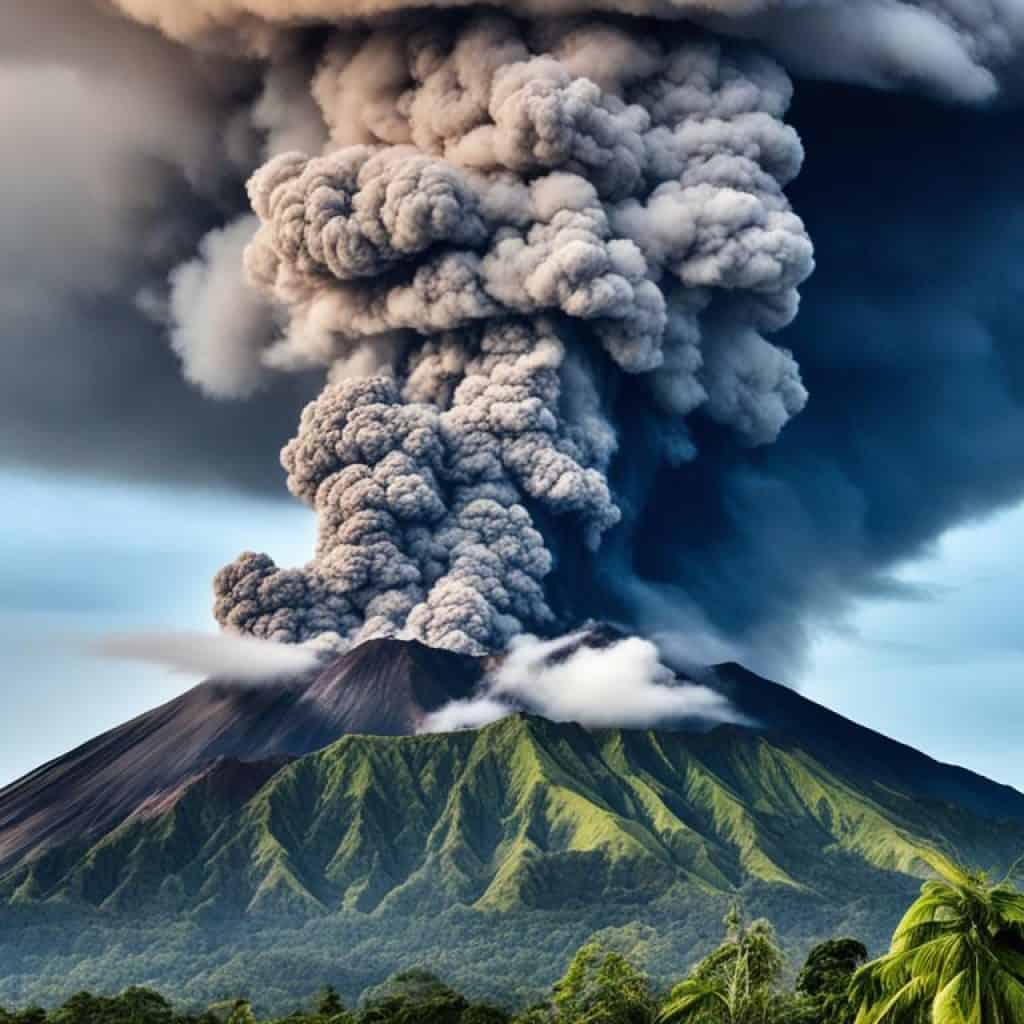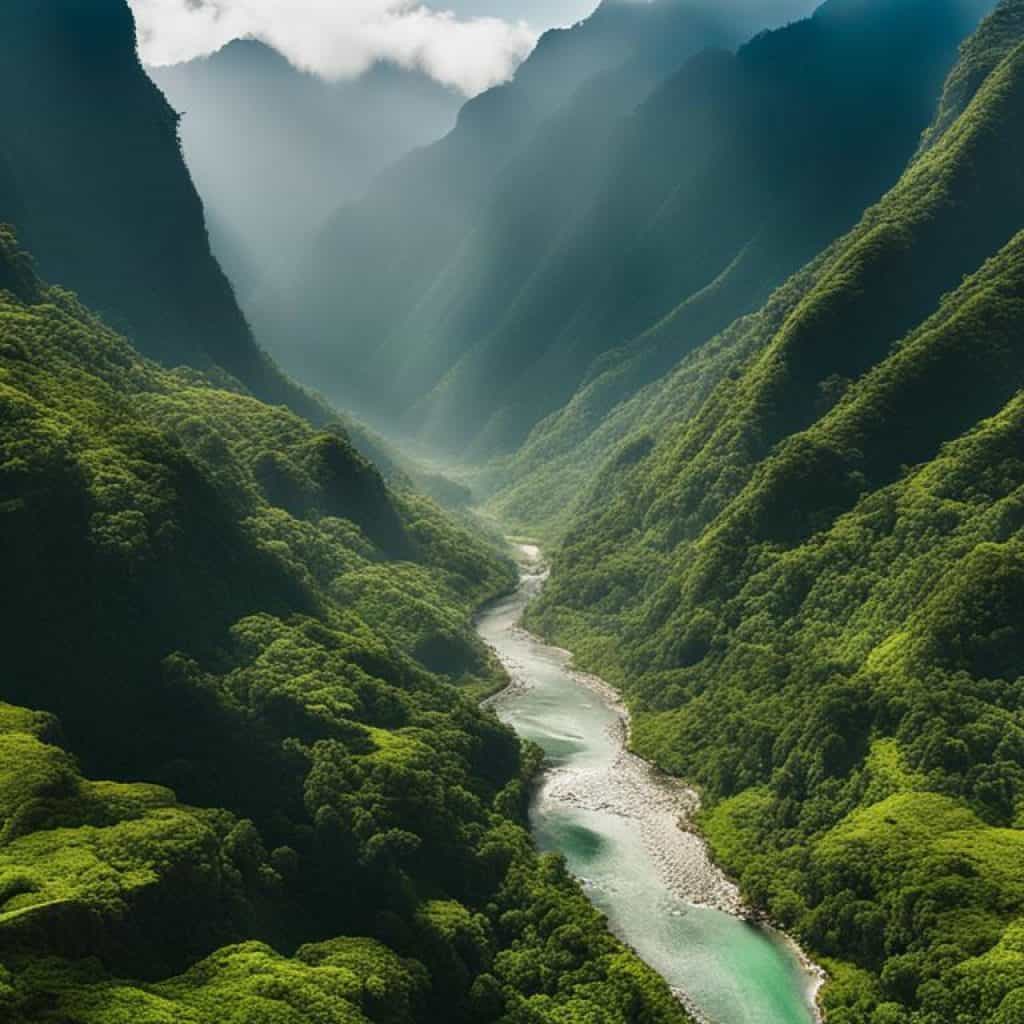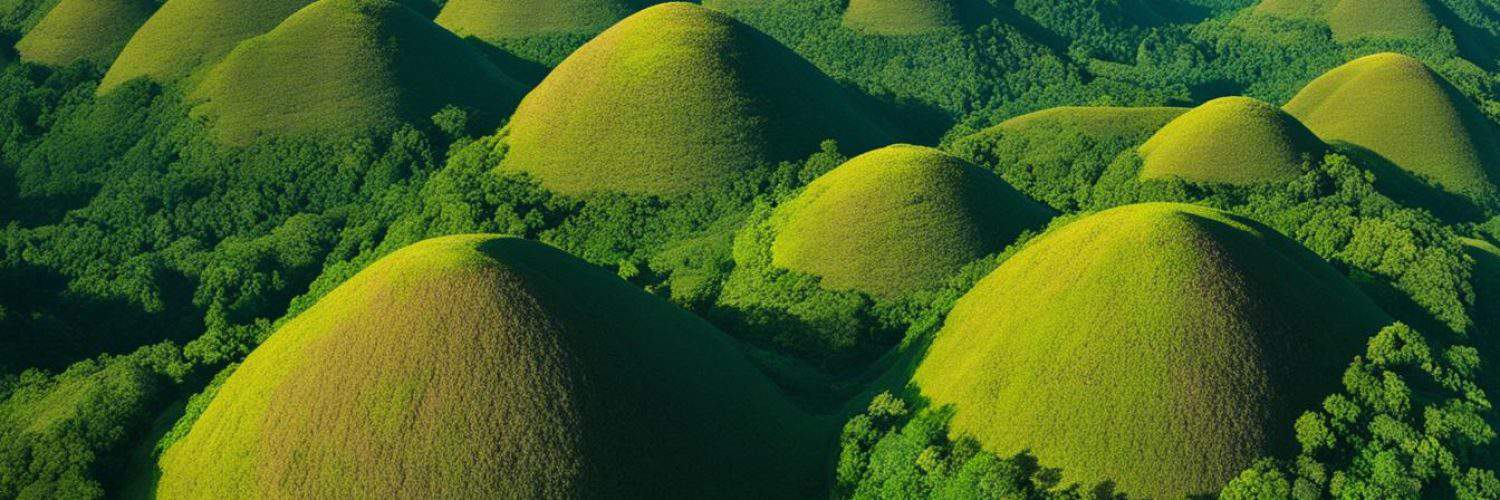Have you ever wondered about the diverse and breathtaking landforms in the Philippines? From towering mountain ranges to picturesque islands, this Southeast Asian country is a treasure trove of natural beauty. But can you name some of the major landforms in the Philippines? Are you familiar with the famous landforms in the Philippines? Let’s embark on a journey through the geographical features in the Philippines and discover the prominent landforms that make this country a paradise for adventure seekers and nature lovers.
Key Takeaways:
- The Philippines is an archipelago composed of 7,107 stunning islands.
- It boasts a variety of landforms, including volcanoes, mountains, plains, valleys, and islands.
- Some of the famous landforms in the Philippines include the Chocolate Hills, Mount Mayon, and Banaue Rice Terraces.
- The country’s natural attractions draw tourists and nature enthusiasts from around the world.
- Exploring the diverse landforms of the Philippines is an adventure that will leave you in awe of the country’s geological wonders.
The Philippine Archipelago
The Philippines is an archipelago located in the Pacific Ocean, made up of 7,107 islands. This unique landform has greatly influenced the country’s cultural diversity and abundance of natural attractions. The Philippine Archipelago offers a captivating mix of stunning landscapes, landforms, and seascapes that make it a paradise for adventurers, nature lovers, and beach enthusiasts.
With its vast expanse of islands, the Philippine Archipelago boasts a diverse range of landforms that showcase the remarkable geology and geography of the region. From majestic mountains and towering volcanoes to picturesque valleys and rolling plains, the Philippines is a treasure trove of natural wonders.
The archipelago’s landforms have played a vital role in shaping the country’s rich history, culture, and society. They have provided habitats for unique flora and fauna, served as centers of economic activity, and offered breathtaking landscapes that have inspired countless stories, legends, and folklore.
Exploring the Philippine Archipelago unveils a world where land and sea harmonize, where dramatic cliffs and karst formations meet crystal-clear waters and pristine beaches. Whether it’s hiking through lush forests, diving into vibrant coral reefs, or simply relaxing on secluded shores, the Philippines offers a myriad of experiences amidst its fascinating landforms.
Embarking on a journey across the Philippine Archipelago allows travelers to discover the country’s unique geography, experience its warm hospitality, and witness firsthand the breathtaking landforms that have made this Southeast Asian nation a top destination for adventurers and explorers.
The Philippine Volcanoes
The Philippines is renowned for its impressive volcanic landscape, boasting a myriad of majestic volcanoes scattered across its islands. Among them, Mount Mayon stands out as one of the most famous and iconic volcanoes in the country.

Mount Mayon, a stratovolcano located in Albay province, is known for its near-perfect cone shape and frequent volcanic activity. Rising to a height of 2,462 meters (8,077 feet), this magnificent volcano captivates visitors with its picturesque beauty and fiery temperament.
The province of Albay, where Mount Mayon is situated, offers a range of activities for adventure-seekers and nature enthusiasts. Travelers can embark on hiking expeditions to witness the awe-inspiring view from the summit or explore the surrounding areas, which are rich in flora and fauna.
As one of the most active volcanoes in the Philippines, Mount Mayon has had numerous eruptions throughout history. The volcano’s last major eruption occurred in January 2018, resulting in ashfall, lahars, and the displacement of thousands of local residents. Despite the risks posed by its volcanic activity, Mount Mayon continues to attract visitors who are drawn to its dramatic beauty and geological significance.
The Philippines is home to a total of 37 known volcanoes, with 18 of them categorized as active. These volcanic wonders shape the country’s landscape and contribute to its unique natural heritage. Volcanic activity in the Philippines is closely monitored by the Philippine Institute of Volcanology and Seismology (PHIVOLCS) to ensure the safety of communities living in the vicinity.
Famous Volcanoes in the Philippines
While Mount Mayon takes the spotlight as the most famous volcano in the Philippines, there are several other notable volcanoes worth exploring:
- Taal Volcano: Located in Batangas province, Taal Volcano is known for its picturesque crater lake and frequent eruptions.
- Mount Pinatubo: Famous for its cataclysmic eruption in 1991, which was one of the largest volcanic eruptions of the 20th century.
- Mount Apo: The highest peak in the Philippines, Mount Apo is a stratovolcano that offers breathtaking hiking trails and scenic views.
These volcanoes, along with Mount Mayon, showcase the Philippines’ geological diversity and attract adventurers and nature lovers from around the world.
Famous Non-Volcanic Mountains, Mountain Ranges, and Hills in the Philippines
Banaue Rice Terraces
“The Banaue Rice Terraces are a true testament to the resourcefulness and ingenuity of the indigenous Ifugao people.” – Local Historian
The Banaue Rice Terraces, a UNESCO World Heritage Site, are an awe-inspiring sight to behold. These age-old terraces were carved by hand over 2,000 years ago by the Ifugao tribe, demonstrating their mastery of the mountainous landscapes. The terraces are not only a testament to the rich cultural heritage of the Philippines but also an engineering marvel, showcasing the ancient farming techniques that have sustained generations.
The Banaue Rice Terraces are often referred to as the “Eighth Wonder of the World” and are a must-visit destination for nature enthusiasts and those seeking unique cultural experiences. The terraces provide a breathtaking view of the surrounding mountains, valleys, and rivers, creating a serene and harmonious landscape.
To fully appreciate the beauty of the Banaue Rice Terraces, visitors can explore the various hiking trails and viewpoints available. These vantage points offer panoramic vistas of the terraces, providing ample opportunities for stunning photographs and unforgettable memories.
| Height (in meters) | Location | Main Attraction |
|---|---|---|
| 1,500 | Batad | Tappiya Waterfall |
| 1,000 | Bangaan | Authentic Ifugao Village |
| 1,700 | Mayoyao | Mayoyao Rice Terraces & Museum |
Visiting the Banaue Rice Terraces is not only an opportunity to witness the beauty of nature but also a chance to support the local communities that have preserved this cultural heritage for centuries. The revenue generated from tourism plays a vital role in the conservation and maintenance of the terraces, ensuring their preservation for future generations to appreciate.
Immerse yourself in the wonders of the Banaue Rice Terraces and discover the remarkable harmony between humanity and nature in the heart of the Philippines.
The Chocolate Hills of Bohol
The Chocolate Hills of Bohol are an extraordinary example of geological formations in the Philippines. These famous landforms consist of approximately 1,776 hills spread across an area of over 50 square kilometers. The hills are covered in lush green grass, creating a stunning landscape that captivates visitors.
What makes the Chocolate Hills truly unique is their transformation during the dry season. As the grass dries up, the hills turn a rich shade of brown, resembling delicious mounds of chocolate. This seasonal change gives them their name and adds to their allure.
The Chocolate Hills are believed to be formed by the uplift of coral deposits and subsequent weathering and erosion over millions of years. This gradual process has shaped these distinct conical hills, making them a geological wonder.

Visitors can explore the Chocolate Hills through various viewpoints and hiking trails. The viewing decks allow you to gaze upon the vast expanse of hills and take in their breathtaking beauty. Be sure to bring your camera to capture the stunning panoramic views.
A Natural Treasure in Bohol
Located in the province of Bohol, the Chocolate Hills are a cherished natural treasure and a popular tourist destination. The local government has taken measures to preserve and protect this natural wonder, ensuring its preservation for future generations.
For nature lovers and adventure enthusiasts, a visit to the Chocolate Hills is a must when exploring the Philippines. The sight of these unique geological formations is truly awe-inspiring and will leave a lasting impression.
Famous Philippine Islands
The Philippines is renowned for its collection of stunning islands that offer breathtaking landscapes and unforgettable experiences. From picturesque beaches to lush tropical forests, these famous Philippine islands attract travelers from around the world. Let’s explore some of the most popular ones:
Hundred Islands of Pangasinan
The Hundred Islands of Pangasinan is a picturesque archipelago composed of 123 islands and islets scattered along the Lingayen Gulf. Its pristine white sand beaches, crystal-clear waters, and captivating limestone formations make it a paradise for beach lovers and adventure seekers.
Palawan Islands
The Palawan Islands, located in the western part of the country, are renowned for their breathtaking beauty and ecological diversity. The archipelago is home to UNESCO World Heritage Sites, including the Puerto Princesa Subterranean River National Park and the Tubbataha Reefs Natural Park. Palawan’s stunning landscapes, including the iconic limestone cliffs of El Nido and the crystal-clear waters of Coron, make it a must-visit destination for nature enthusiasts.
Boracay Island
Boracay Island is famous for its powdery white sand beaches and vibrant nightlife. This small tropical paradise offers a wide range of water activities, such as snorkeling, scuba diving, and parasailing. It also boasts world-class resorts, restaurants, and shopping establishments, ensuring a memorable and luxurious vacation experience.
Corregidor Island
Corregidor Island, often called “The Rock,” is a historic island fortress located at the entrance of Manila Bay. It played a significant role during World War II, serving as a strategic defense outpost. Today, visitors can explore the island’s ruins, tunnels, and museums to gain a deeper understanding of its wartime history.
These famous Philippine islands exemplify the country’s natural beauty and cultural richness. Whether you’re seeking relaxation, adventure, or a glimpse into history, the Philippines offers an unforgettable experience on its stunning islands.
| Island | Main Attractions |
|---|---|
| Hundred Islands of Pangasinan | Pristine white sand beaches, crystal-clear waters, limestone formations |
| Palawan Islands | UNESCO World Heritage Sites, stunning landscapes, limestone cliffs, crystal-clear waters |
| Boracay Island | White sand beaches, vibrant nightlife, water activities, luxury resorts |
| Corregidor Island | Historic ruins, tunnels, museums, wartime history |
Philippine Valleys
The Philippines is abundant in valleys, offering breathtaking landscapes and playing a crucial role in the country’s agricultural productivity. Two notable valleys that stand out are the Cagayan Valley and Trinidad Valley.
The Cagayan Valley, located in the northern part of Luzon, is often referred to as the “Rice Granary of the Philippines.” It is known for its fertile soil, making it an ideal region for rice production and farming. The valley’s picturesque scenery enhances its charm, with lush rice fields, flowing rivers, and rolling hills creating a captivating vista.
Trinidad Valley, situated in Benguet province, boasts stunning natural beauty and is famous for its vegetable terraces. The valley showcases the ingenuity of local farmers, who skillfully carve steep mountainsides into terraced fields, enabling sustainable agriculture. The vibrant green hues of the terraces against the backdrop of towering mountains create a mesmerizing sight that attracts visitors from around the world.
Both the Cagayan Valley and Trinidad Valley offer visitors a chance to immerse themselves in the natural splendor of the Philippine countryside. Exploring these valleys provides a unique insight into the agricultural heritage of the country, as well as an opportunity to witness the skill and dedication of local communities.

Embracing the charm of the Philippine valleys, with their scenic landscapes and thriving agricultural industries, is a must for any traveler seeking a deeper connection with the country’s natural heritage. The diverse beauty of the Cagayan Valley and Trinidad Valley showcases the Philippines’ rich and enchanting landforms, offering an unforgettable experience to all who visit.
Plains and Flat Lands
The Philippines is home to vast plains and flat lands that play a significant role in the country’s agriculture. These expansive areas are primarily utilized for rice cultivation, making the Philippines one of the major rice-producing countries in the world. The fertile plains provide ideal conditions for growing rice, contributing to the country’s food security and economy.
However, these plains and flat lands are not without challenges. Due to their low-lying nature, they are susceptible to flooding during the rainy season. Heavy rainfall can cause water levels to rise quickly, resulting in temporary inundation of these flat regions. Despite these seasonal challenges, the resilience of the Filipino farmers and the effectiveness of agricultural practices have enabled them to adapt and utilize these plains sustainably.
“Being one of the world’s leading rice producers, the plains and flat lands in the Philippines play a crucial role in ensuring food security and maintaining agricultural productivity.”
To mitigate the risk of flooding, farmers have implemented innovative strategies such as constructing irrigation systems and adopting efficient water management techniques. These measures help ensure the proper drainage of water, preventing excessive flooding and minimizing crop damage. The resilience and resourcefulness of Filipino farmers have allowed them to turn these challenges into opportunities for growth and sustainable agriculture.
| Advantages | Disadvantages |
|---|---|
|
|
The plains and flat lands in the Philippines are not only important for agriculture but also contribute to the scenic beauty of the country. These open landscapes, stretching as far as the eyes can see, offer breathtaking views and picturesque vistas, attracting both local and international tourists. The vastness of these plains provides a sense of tranquility and offers visitors a unique opportunity to experience the natural beauty of the Philippines.
Despite the occasional challenges posed by flooding, the plains and flat lands of the Philippines remain a vital component of the country’s agricultural landscape and cultural heritage. The resilience, ingenuity, and resourcefulness of the Filipino people continue to ensure the sustainable cultivation of these plains, supporting the nation’s food security, economy, and natural beauty.
Conclusion
The landforms in the Philippines are a testament to the country’s natural beauty and geographical diversity. From towering volcanoes and majestic mountain ranges to breathtaking islands and lush valleys, the Philippines offers a wide variety of stunning landscapes for visitors to explore.
These diverse landforms make the Philippines a sought-after destination for adventure seekers and nature enthusiasts alike. Whether you’re hiking the slopes of Mount Mayon, marveling at the Chocolate Hills of Bohol, or relaxing on the pristine beaches of Boracay Island, there’s something for everyone in this tropical paradise.
The country’s rich and varied landforms also contribute to its cultural heritage. The Banaue Rice Terraces, carved into the mountains by the Ifugao tribe, are a testament to centuries-old agricultural practices and an awe-inspiring example of human ingenuity.
With its wide range of landforms, the Philippines truly offers a diversity of natural attractions that is unparalleled. So, whether you’re looking for adventure, relaxation, or a glimpse into the country’s fascinating history, the landforms of the Philippines are sure to leave a lasting impression.
FAQ
What are some major landforms in the Philippines?
The Philippines is known for its diverse landforms, including mountain ranges, volcanoes, plains, hills, valleys, and islands.
How many islands are there in the Philippines?
The Philippines is an archipelago made up of 7,107 islands.
What is the most famous volcano in the Philippines?
Mount Mayon is the most famous volcano in the Philippines, known for its perfectly shaped cone and frequent eruptions.
Are there any non-volcanic mountains in the Philippines?
Yes, the Philippines is home to non-volcanic mountains and mountain ranges, including the Banaue Rice Terraces, a UNESCO World Heritage Site created by the ancient Ifugao tribe.
What are the Chocolate Hills of Bohol?
The Chocolate Hills of Bohol are a unique geological landform consisting of approximately 1,776 grass-covered hills that turn brown during the dry season, resembling chocolate mounds.
What are some famous islands in the Philippines?
Some famous Philippine islands include the Hundred Islands of Pangasinan, Palawan Islands, Boracay Island, and Corregidor Island.
Are there any notable valleys in the Philippines?
Yes, the Philippines is home to notable valleys such as the Cagayan Valley and Trinidad Valley, known for their agricultural productivity and scenic beauty.
Are there any plains and flat lands in the Philippines?
Yes, there are vast plains and flat lands in the Philippines, primarily used for rice cultivation, but they are also prone to flooding during the rainy season.
Why is the Philippines a popular destination for tourists and nature enthusiasts?
The Philippines is famous for its diverse landforms and natural attractions, which include volcanoes, mountains, hills, islands, valleys, plains, and more. These unique features make it a popular destination for tourists and nature enthusiasts.


















Add comment